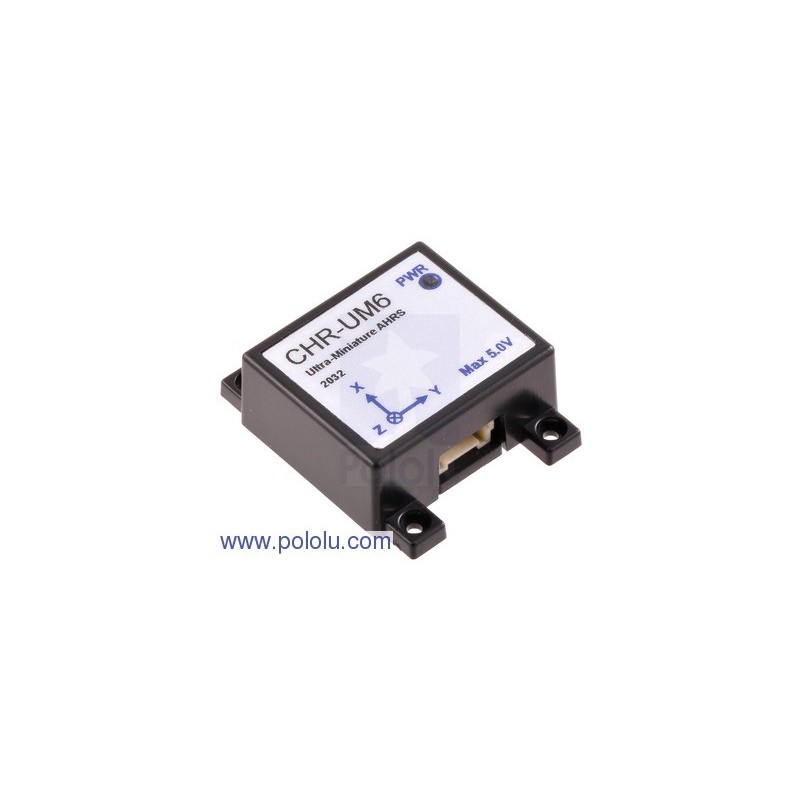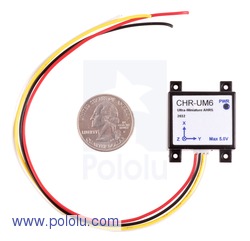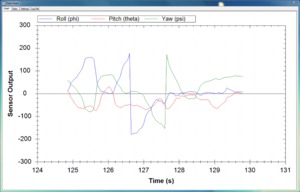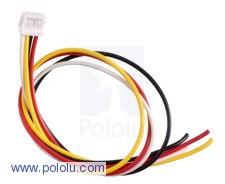- Obecnie brak na stanie

CHR-UM6 Orientation Sensor
The UM6 ultra-miniature orientation sensor from CH Robotics uses rate gyros, accelerometers, magnetic sensors, and an onboard 32-bit ARM Cortex processor to compute sensor orientation 1000 times per second. Sensor orientation is reported using either quaternions or Euler angles over a TTL serial interface at user-customizable rates. The UM6 was designed specifically to be easy to use — an external enclosure protects sensitive electronics, and connectors make it easy to interface with the sensor without making solder connections to the sensor itself.
 |
 |
The UM6 ultra-miniature orientation sensor—also known as an Attitude and Heading Reference System, or AHRS—from CH Robotics is much more than an IMU. It uses rate gyros, accelerometers, magnetic sensors, and an onboard 32-bit ARM Cortex processor to estimate the absolute sensor orientation 1000 times per second. Sensor orientation is reported using either quaternions or Euler angles over a TTL serial interface at user-customizable rates. A USB-to-serial adapter can be used to connect the IMU to a computer running the free CH Robotics Serial Interface PC application, which allows for easy data visualization, board calibration, and UM6 settings configuration.
The CHR-UM6 was designed specifically to be simple to use: an external enclosure protects sensitive electronics, its small size (1.1"×1.4"×0.5") makes it easier to fit into the end system, and connectors mean no soldering to the sensor itself is required. A polarized four-pin male connector on the side of the UM6 matches an included 7.5" cable and provides the lines necessary to power the board and use the main TTL serial interface. Two 12-pin female connectors on the underside of the UM6 provide access to these same pins along with additional, unused Cortex pins and allow the sensor to be plugged directly into a host system, removing the need to run wires to enable the sensor to communicate. (Note: a version of this sensor is also available without the enclosure or connectors.)
The UM6 can be configured to automatically transmit raw sensor data, processed sensor data, and angle estimates at user configurable rates ranging from 20 Hz to 300 Hz in roughly 1 Hz increments. Alternatively, the UM6 can operate in “silent mode,” where data is transmitted only when specific requests are received over the UART. Regardless of the transmission mode and rate, internal angle estimates are updated at 1000 Hz to improve accuracy.
The UM6 simplifies integration by providing a number of automatic calibration routines, including rate gyro bias calibration, magnetometer hard and soft iron calibration, and accelerometer “zeroing” to compensate for sensor-platform misalignment. All calibration routines are triggered by sending simple commands over the serial interface.
The UM6 comes factory-calibrated to remove soft and hard iron distortions present in the enclosure. When integrated into the end-user system, additional calibration may be necessary to correct other magnetic field distortions. Magnetometer calibration can be performed using the CH Robotics Serial Interface software.
As of firmware revision UM2B, the UM6 has the ability to interface with an external GPS module to provide position, altitude, speed, and course outputs. Any GPS module that communicates using industry-standard NMEA sentences, such as our LS20031 GPS receiver module, can be used with the UM6.
June 1, 2012 Update: We are now shipping CHR-UM6 sensors with the latest firmware version (UM2B), which supports a direct interface with GPS modules; if you have a sensor with the previous firmware version, you can update the firmware using the CH Robotics Serial Interface or with this process described on the CH Robotics forum.
We carry several inertial measurement and orientation sensors. The table below compares their capabilities:
| Product Name | Sensors | Estimation | Other | |||||
| Gyros (3x) | Accels (3x) | Mag (3x) | Roll | Pitch | Yaw | Quaternion | Enclosure | |
| Pololu MinIMU-9 v2 |
 |
 |
 |
|||||
| CHR-UM6-LT Orientation Sensor |
 |
 |
 |
 |
 |
 |
 |
|
| CHR-UM6 Orientation Sensor |
 |
 |
 |
 |
 |
 |
 |
 |
 |
| Graph of all three Euler angles displayed by the CH Robotics Serial Interface connected to a CHR-UM6 orientation sensor. |
|---|
 |
| Cable included with the CHR-UM6 orientation sensor. |
|---|
The CHR-UM6 can be used in applications where a compact attitude and heading reference system is needed:
 |
Pololu USB-to-Serial Adapter |
 |
USB Cable A to Mini-B 6 ft. |
 |
66-Channel LS20031 GPS Receiver Module |
Producent BTC Korporacja sp. z o. o. Lwowska 5 05-120 Legionowo Polska sprzedaz@kamami.pl 22 767 36 20
Osoba odpowiedzialna BTC Korporacja sp. z o. o. Lwowska 5 05-120 Legionowo Polska sprzedaz@kamami.pl 22 767 36 20
Brak towaru
Stabilizowany zasilacz laboratoryjny Wanptek z płynną regulacją napięcia w zakresie od 0 do 30V oraz prądu w zakresie od 0 do 5A. Wanptek KPS305D
Brak towaru
Izopropanol 70% (IPA) to skuteczny i bezpieczny środek czyszczący o niskiej przewodności elektrycznej, dostarczany w plastikowej butelce 500ml z bezpieczną nakrętką, doskonale sprawdzający się w profesjonalnym warsztacie elektronika dzięki swoim właściwościom odtłuszczającym, szybkiemu parowaniu i precyzyjnemu dozowaniu
Brak towaru
Brak towaru
Brak towaru
Wysokiej jakości preparat przeznaczony do regeneracji i konserwacji potencjometrów.
Brak towaru
Zasilacz Akyga AK-B1-400S przeznaczony do zasilania komputerów stacjonarnych. Zgodny ze standardem ATX 2.31, moc 400W. Akyga AK-B1-400S
Brak towaru
Brak towaru
Brak towaru
Brak towaru
Brak towaru
Brak towaru
Brak towaru
Brak towaru
BleBox BleBoxProbe to precyzyjna, wodoodporna sonda cyfrowa, idealna do kontroli temperatury w różnych warunkach, kompatybilna z urządzeniami BleBox
Brak towaru
Brak towaru

CHR-UM6 Orientation Sensor
